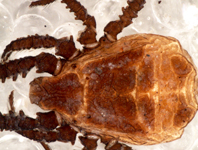Abstract
Two new caeculid mite species, Andocaeculus beatrizrosso sp. nov. and Andocaeculus burmeisteri sp. nov., are described and A. weyrauchi (Franz, 1964) is redescribed based on material collected at the type locality. All post-larval stages are described for A. weyrauchi and Andocaeculus beatrizrosso sp. nov. and stochastic variation in the idiosomal and appendages chaetotaxy is considered. A clade of Andocaeculus containing the three species (the A. weyrauchi group) is established based on morphological characters, and confirmed with a Bayesian phylogenetic analysis of sequences from the CO1 marker. As result of the same analysis, the absence of the (st) pair of setae on leg II is proposed as a derived condition for the genus Andocaeculus, and the presence of the φ solenidion on leg IV is a derived condition for some Andocaeculus species of the A. weyrauchi species group.
References
Arana, M.D., Martínez, G.A., Oggero, A.J., Natale, E.S. & Morrone, J.J. (2017) Map and shapefile of the biogeographic provinces of Argentina. Zootaxa, 4341 (3), 420–422.
https://doi.org/10.11646/zootaxa.4341.3.6
Berlese, A. (1883) Acari, Myriapoda et Scorpiones huscque in Italia reperta. Vol. 6. Sumptibus Auctoris, Padova. Availabel from: http://www.marinespecies.org/aphia.php?p=sourcedetails&id=244839 (accessed 16 February 2021)
Berlese, A. (1916) Centuria terza di Acari nuovi. Redia, 12, 289–338.
Bernard, J., Lumley, L.M., Buck, M. & Cobb, T.P. (2020) A new species of rake-legged mite, Caeculus cassiopeiae (Prostigmata, Caeculidae), from Canada and a systematic analysis of its genus. ZooKeys, 926, 1–23. https://doi.org/10.3897/zookeys.926.48741
Coineau, Y. (1967) Contribution à l’étude des Caeculidae. Troisième série. Développement postlarvaire de Neocaeculus luxtoni n. gen., n. sp. Acarologia, 9 (1), 55–75.
Coineau, Y. (1968) Contribution a l’etude des Caeculidae. 7e serie. Microcaeculus franzi n. sp., Caeculidae sabulicole de Corse. Vie et Milieu, Serie C, Biologie Terrestre, 19 (1), 143–158.
Coineau, Y. (1969) Contribution a l’etude des Caeculidae. Sixieme serie. Microcaeculus sabulicola Franz, 1952. Redescription, chetotaxie et repartition. Acarologia, 11 (2), 207–221.
Coineau Y. (1974a) Elements pour une monographie morphologique, ecologique et biologique des Caeculidae (Acariens). Memoires du Museum National d’Histoire Naturelle, Serie A, Zoologie, 81, 1–299, pls. 1–24.
Coineau, Y. (1974b) Contribution à l’étude des Caeculidae. Neuvième partie. Deux nouvelles espèces de Caeculidae de la région Australienne Neocaeculus johnstoni n. sp. et N. womersleyi n. sp. Vie et Milieu, 24 (1), 65–86.
Coineau, Y. & Enns, W.R. (1969) Contribution à l’étude des Caeculidae (Acariens, Prostigmates). 8e série. Deux nouvelles espèces d’Australie: Neocaeculus knoepffleri n. sp.; N. bornemisszai n. sp. Acarologia, 11 (4), 207–221.
Folmer, O., Black, M., Hoeh, W., Lutz, R. & Vrijenhoek, R. (1994) DNA primers for amplification of mitochondrial cytochrome c oxidase subunit I from diverse metazoan invertebrates. Molecular Marine Biology and Biotechnology, 3, 294–299.
Franz, H. (1962) Ein neuer Microcaeculus aus Südamerika. (Acari, Trombidiformes) Verhandlungen der Zoologisch-Botanischen Gesellschaft in Wien, 101–102, 98–100.
Franz, H. (1964) Neue Caeculiden aus Afrika und Südamerika. Verhandlungen der Zoologisch-Botanischen Gesellschaft in Wien, 103–104, 82–93.
Fuangarworn, M. & Butcher, B. (2015) Neocaeculus orientalis sp. nov. (Acari, Trombidiformes, Caeculidae) from Thailand. Zootaxa, 4048 (2), 251–268
https://doi.org/10.11646/zootaxa.4048.2.6
Hebert, P.D.N., Penton, E.H., Burns, J.M., Janzen, D.H. & Hallwachs, W. (2004) Ten species in one: DNA barcoding reveals cryptic species in the neotropical skipper butterfly Astraptes fulgerator. Proceedings of the National Academy of Sciences USA, 101, 14812–14817.
https://doi.org/10.1073/pnas.0406166101
Ivanova, N.V., deWaard, J.R. & Hebert, P.D.N. (2006) An inexpensive, automation-friendly protocol for recovering high-quality DNA. Molecular Ecology Notes, 6, 998–1002.
https://doi.org/10.1111/j.1471-8286.2006.01428.x
Kalyaanamoorthy, S., Minh, B.Q., Wong, T.K.F., von Haeseler, A. & Jermiin, L.S. (2017) ModelFinder: Fast model selection for accurate phylogenetic estimates. Nature Methods, 14, 587–589.
https://doi.org/10.1038/nmeth.4285
Kethley, J. (1990) Acarina: Prostigmata (Actinedida). In: Dindal, D.L. (Ed.), Soil Biology Guide. John Wiley & Sons, New York, pp. 667–756.
Nguyen, L.-T. , Schmidt, H.A. von Haeseler, A. & Minh, B.Q. (2015) IQ-TREE: A fast and effective stochastic algorithm for estimating maximum likelihood phylogenies. Molecular Biology and Evolution, 32, 268–274. https://doi.org/10.1093/molbev/msu300
McDaniel, B. & Boe, A. (1990) A new species and distribution record for the genus Caeculus Dufour (Acari: Caeculidae) from South Dakota. Proceedings of the Entomological Society of Washington, 92 (4), 716–724.
Ott, A.P. & Ott, R. (2014) A new species of Andocaeculus (Acari, Caeculidae) from the Pampa biome, southern Brazil. Iheringia, Série Zoologia, 104 (3), 355–363.
https://doi.org/10.1590/1678-476620141043355363.
Ott, A.P. & Ott, R. (2018) A new species of rake-legged mite Neocaeculus (Acari, Caeculidae) from Brazilian semiarid and new data on distribution of Andocaeculus caioi. Iheringia. Série Zoologia, 108, e2018027. [epub 25 June 2018)
https://doi.org/10.1590/1678-4766e2018027
Otto, J.C. (1993) A new species of Microcaeculus from Australia (Acarina: Caeculidae), with notes on its biology and behavior. International Journal of Acarology, 19 (1), 3–13.
https://doi.org/10.1080/01647959308683533
Porta, A.O. & Vázquez Rojas, I (2020) A new Caeculus (Prostigmata: Caeculidae) from Mexico, with an updated key for the genus. Systematic and Applied Acarology, 25(4), 743–758.
https://doi.org/10.11158/saa.25.4.13
Porta, A.O., Proud, D.N., Franchi, E., Porto, W., Epele, M.B. & Michalik, P. (2019) The first record of caeculid mites from the Cretaceous amber of Myanmar with notes on the phylogeny of the family. Zootaxa, 4647 (1), 023–043.
https://doi.org/10.11646/zootaxa.4647.1.5
Rambaut, A. (2018) FigTree. Version 1.4.4. Available from: http://tree.bio.ed.ac.uk/software-/figtree/ (accessed 25 December 2018)
Rambaut, A., Drummond, A.J., Xie, D., Baele, G. & Suchard, M.A. (2018) Posterior summarization in Bayesian phylogenetics using Tracer 1.7. Systematic Biology. syy032.
https://doi.org/10.1093/sysbio/syy032
Ronquist, F., Teslenko, M., van der Mark, P., Ayres, D.L., Darling, A., Höhna, S., Larget, B., Liu, L., Suchard, M.A. & Huelsenbeck, J.P. (2012) MRBAYES 3.2: Efficient Bayesian phylogenetic inference and model selection across a large model space. Systematic Biology, 61, 539–542.
https://doi.org/10.1093/sysbio/sys029
Taylor, C.K., Gunawardene, N.R. & Kinnear, A. (2013) A new species of Neocaeculus (Acari: Prostigmata: Caeculidae) from Barrow Island, Western Australia, with a checklist of world Caeculidae. Acarologia, 53 (4), 439–452.
https://doi.org/10.1051/acarologia/20132105
Walter, D.E., Lindquist, E.E., Smith, I.M., Cook, D.R. & Krantz, G.W. (2009) Order Trombidiformes. In: Krantz, G.W. & Walter, D.E. (Eds.), A Manual of Acarology. 3rd Edition. Texas Tech University Press, Lubbock, Texas, pp. 233–429.


